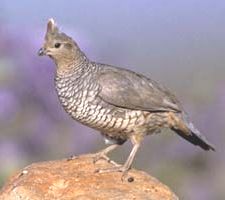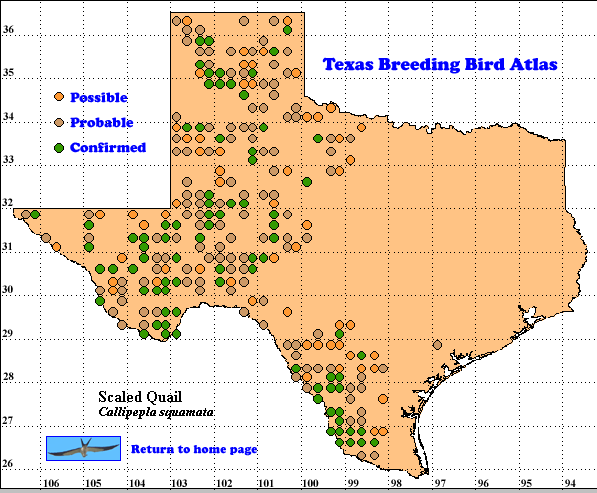The Scaled Quail, also known as Blue Quail or Cottontop Quail, is a familiar bird of arid west and south Texas. Relatively little research has been conducted on this game species, and many aspects of its natural history remain unknown (Schemnitz 1994). It is primarily a terrestrial bird, preferring to run rather than fly at the threat of danger. The Scaled Quail is enjoyed by hunters, as well as other outdoor enthusiasts in pursuit of this elusive shrubland bird. Scaled Quail inhabits the Chihuahuan Desert and adjacent desert grasslands (Johnsgard 1973) of southeast Arizona, New Mexico, southeast Colorado, southwest Kansas, western Oklahoma, and western Texas (Am. Ornithol. Union 1998). It also occupies in thorn scrub habitat of northern and central Mexico (Howell and Webb 1995). The highest densities of Scaled Quail in the United States occur in Texas (Church et al. 1993).
Two of the four subspecies of Scaled Quail occur in Texas. The most abundant subspecies, C. s. pallida, resides in the High and Rolling Plains, Trans-Pecos, and Edwards Plateau regions of Texas. C. s. castanogastris inhabits the South Texas Plains. A region of overlap between the two subspecies occurs in Val Verde, Kinney, and Uvalde counties (TGFOC 1945). No distinction between the two subspecies was made for TBBA records.
DISTRIBUTION: Scaled Quail distribution in Texas is confined to western regions of the state. Annual rainfall is apparently the factor which limits the Scaled Quail’s range. Habitats which receive more than 67 cm (27 in) of rain/year are too densely vegetated to be occupied by this species (Oberholser 1974, Reid et al. 1993). The lack of breeding records for the Edwards Plateau (latilongs 29099, 29100, 30099, and 30100) and the High Plains (latilongs 34101 and 34102) is attributed to human population densities and/or unsuitable habitat, and is substantiated by previous accounts (Oberholser 1974, TGFOC 1945). The gap in breeding records for the Trans-Pecos region is apparently due to lack of coverage in TBBA records. The highest density of confirmed records occurred in the mesquite brushlands of the South Texas Plains. However, Reid et al. (1993) recorded the highest Scaled Quail densities in the Trans-Pecos region.
SEASONAL OCCURRENCE: Scaled Quail are nonmigratory and generally occupy the same area during summer and winter (Schemnitz 1994). The species has a long nesting season that begins later than most desert-nesting birds (Johnsgard 1973). Scaled Quail egg dates range from March 11 to September 9 in Texas (Oberholser 1974). Most nesting activity, however, takes place in June and July which is reflected by TBBA records.TBBA data demonstrate the difficult nature of determining Scaled Quail breeding status. Only 26% of TBBA records (n = 408) confirmed breeding. Of the confirmed records, only 9% represented nests which were discovered with eggs or young. Young Scaled Quail are very precocial, and immediately follow the parents upon hatching. This is illustrated by the high number of fledgling observations (89%) in the confirmed breeding records.
BREEDING HABITAT. Scaled Quail prefer shrubland habitats with an abundance of low shrubs for overhead protection and sparse, but diverse, understories of grasses and forbs (Reid et al. 1993, Wilson and Crawford 1987). Preferred shrubs include mesquite, four- wing saltbush, littleleaf and skunkbush sumac, creosote bush, sandsage, yucca, and various cacti (Schemnitz 1994). Densely vegetated habitats that impede the quail’s movement or escape from predators are avoided. Croplands and open grasslands are also seldom utilized by this species (Schemnitz 1964, Reid et al. 1993)
Scaled Quail nests are shallow depressions on the ground sparsely lined with dried grass or leaves, and are remarkably well concealed beneath low shrubs or dense clumps of vegetation. This species is even known to nest under man-made structures such as farm equipment (Schemnitz 1994). Scaled Quail typically rear only one brood, unlike other quail (Wallmo 1957). Incubation is done primarily by the female, but both parents attend fledged young (Schemnitz 1994)
STATUS: Historically, the Scaled Quail’s range extended eastward to the western boundary of woodlands in Texas (Wallmo 1957). In recent decades Scaled Quail populations have declined in Texas and across the United States. This decline has been attributed to habitat loss as a result of excessive cattle grazing and “clean” farming practices (TGFOC 1945, Schemnitz 1994). TBBA records and recent North American Breeding Bird Survey data (Sauer et al. 2005) reveal a significant reduction in the eastern edge of the Scaled Quail’s range compared to Oberholser (1974). This range constriction is especially apparent in the Edwards Plateau and South Texas Plains regions. Previously, Scaled Quail ranged west of a line extending from Coleman to Mason, Kendall, Wilson, Bee, Kleberg, and Hidalgo counties. TBBA records show the Scaled Quail’s range now extends west from Coleman, Crockett, Val Verde, Medina, Live Oak, and Hidalgo counties. Scaled Quail is absent from the Edwards Plateau and South Texas Plains regions (Lockwood and Freemsn 2004). An area of apparent range extension is the northernmost portions of the High and Rolling Plains (latilongs 34100, 35100, and 36100) which were excluded from the species distribution in 1945 (TGFOC 1945).
One exceptional TBBA record of multiple singing males was recorded in northern Victoria County (latilong 28096). Scaled Quail have been recorded in adjacent Goliad County (TGFOC 1945), and Oberholser (1974) reported stragglers as far east as Fannin, Tarrant, and Travis counties. The Victoria Co. record, however, represents the easternmost record of this species during the breeding season.
Text by Greg Creacy (Posted with updates 2006)
Literature cited.
American Ornithologists’ Union. 1998. Checklist of North American birds, 7th ed. Am, Ornithol. Union, Washington, DC.
Church, K. E., J. R. Sauer, and S Droege. 1993. Population trends of quails in North America. Proc. Natl. Symp. Quail III: 44-54.
Howell, S. N. G. and S. Webb. 1995. A guide to the birds of Mexico and northern Central America. Oxford University Press, New York.
Johnsgard, P. A. 1973. Grouse and quails of North America. University of Nebraska Press, Lincoln..
Lockwood, M. W. and B. Freeman. 2004. The TOS handbook of Texas birds. Texas A&M University Press, College Station.
Oberholser, H. C. 1974. The bird life of Texas, University of Texas Press, Austin.
Reid, R. R., C. E. Grue, and N. J. Silvy. 1993. Habitat requirements of breeding Scaled Quail in Texas. Proc. Natl. Symp. Quail: 137-142.
Sauer, J. R., J. E. Hines, and J. Fallon. 2005. The North American Breeding Bird Survey, results and analysis 1966-2005. Version 6.2 2006. USGS Patuxent Wildlife Research Center, Laurel MD < http://www.mbr-pwrc.usgs.gov/bbs>
Schemnitz, S. D. 1964. Comparative ecology of bobwhite and Scaled Quail in the Oklahoma Panhandle. Am. Midl. Nat. 71: 429-433.
Schemnitz, S. D. 1994. Scaled Quail (Callipepla squamata). In The birds of North America, No. 106 (A. Poole and F. Gill, eds.). The Birds of North America, Inc., Philadelphia, PA.
Texas Game, Fish, and Oyster Comm. 1945. Principal game birds and mammals of Texas. TGFOC, Austin.
Wallmo, O. C. 1957. Ecology of Scaled Quail in west Texas. Ph.D.diss., Texas A&M Univ., College Station.
Wilson, M. H. and J. A. Crawford. 1987. Habitatselection by Texas bobwhites and chest-bellied Scaled Quail in south Texas. J. Wildl. Manage 51: 575-582.

